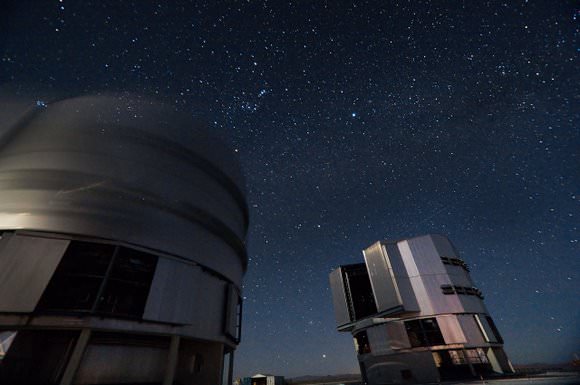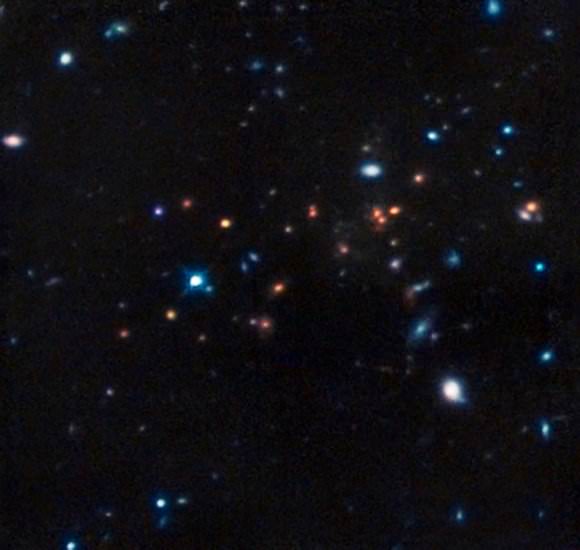[/caption]
The galaxies above are among the oldest objects astronomers have ever laid eyes — er, telescopes — on, formed when the Universe was less than a quarter of its current age. In a new study out in the journal Astronomy & Astrophysics, a team of researchers has announced that they’ve used a fleet of the world’s most powerful telescopes to measure the distance from here to there.
And things look awfully familiar.
“The surprising thing is that when we look closely at this galaxy cluster it doesn’t look young — many of the galaxies have settled down and don’t resemble the usual star-forming galaxies seen in the early Universe,” said lead author Raphael Gobat of Université Paris Diderot in France.

Clusters of galaxies are the largest structures in the Universe that are held together by gravity. Astronomers expect these clusters to grow over time so that massive clusters would be rare in the early Universe. Although even more distant clusters have been seen, they appear to be young clusters in the process of formation, not settled mature systems.
The international team of astronomers used the powerful VIMOS and FORS2 instruments on ESO’s Very Large Telescope (VLT) to measure the distances to some of the blobs in a curious patch of very faint red objects first observed with the Spitzer space telescope. This grouping, named CL J1449+0856 for its position in the sky, had all the hallmarks of being a very remote cluster of galaxies. The results showed that we are indeed seeing a galaxy cluster as it was when the Universe was about three billion years old.
Once the team knew the distance to this very rare object, they looked carefully at the component galaxies using both Hubble and ground-based telescopes, including the VLT. They found evidence suggesting that most of the galaxies in the cluster were not forming stars, but were composed of stars that were already about one billion years old. This makes the cluster a mature object, similar in mass to the Virgo Cluster, the nearest rich galaxy cluster to the Milky Way.
Further evidence that this is a mature cluster comes from observations of X-rays coming from CL J1449+0856 made with ESA’s XMM-Newton space observatory. The cluster is giving off X-rays that must be coming from a very hot cloud of tenuous gas filling the space between the galaxies and concentrated towards the center of the cluster. This is another sign of a mature galaxy cluster, held firmly together by its own gravity, as very young clusters have not had time to trap hot gas in this way.
As Gobat concludes, “These new results support the idea that mature clusters existed when the Universe was less than one quarter of its current age. Such clusters are expected to be very rare according to current theory, and we have been very lucky to spot one. But if further observations find many more then this may mean that our understanding of the early Universe needs to be revised.”
Source: ESO press release. The research appears in a paper, “A mature cluster with X-ray emission at z = 2.07,” by R. Gobat et al., published in the journal Astronomy & Astrophysics. (see also arxiv). Lead author’s affiliation page: Université Paris Diderot.


From sub-atomic particles to atomic particles to planets, stars and galaxies, spin features.
Is it known if galaxy clusters show any spin?
Do the lines on which the clusters are found show any spin of the clusters about the lines?
Not quite. Spin is not rotation, even if both show conservation under observation as angular momentum.
Spin in elementary particles is a geometrical feature that tells you how many times you have to turn an object to get it back as to overlap the initial state. For example, spin-1/2 particles like the electron have to be turned 2 times to look as when they started (as 2*1/2 = 1):
“For example, rotating a spin-1/2 particle by 360 degrees does not bring it back to the same quantum state, but to the state with the opposite quantum phase; this is detectable, in principle, with interference experiments.”
Wow, this is the first time I actually get a beginning of a notion about spin! 😀
Manu, your comment about spin reminds me of this comic: http://abstrusegoose.com/342
I should also point out that this is how we know that electrons are point particles (or strings), because it turns out that when you try to model them classically as charged shells (since the inner of a charged conducting region would be non-charged like a Faraday’s cage) you find that you cannot with the observed values. The shell would be rotating faster than the speed of light, IIRC.
Hence quantum mechanics and “true” point particles (or strings) to the rescue!
A galaxy cluster rotates around the center of mass of that cluster.
There were galaxy clusters at 3 billion years, or what I guestimate at near z = 1.
A galaxy cluster may have some net angular momentum as defined by the rotation of each galaxy and their relative motions.
LC
Great description of spin, and a great cartoon. I still don’t think I completely understand spin, but it’s a good start.
TL, OM: Am I to understand electrons are now thought of as point particles again, and not waves?
Um, what? QM allows for wavefunctions, spread out and localized both. This has, erroneously, historically once been referred to as “wave-particle dualism”.
Localized wavefunctions may be identified with particles (classically) or strings. I was using particles as a model because it was both enough and suited the subject better.